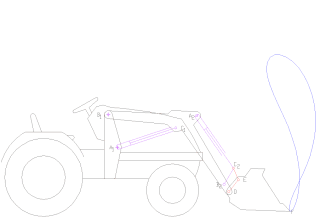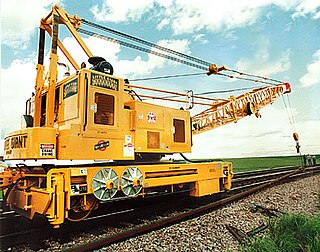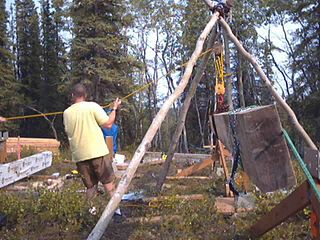
A forklift is a powered industrial truck used to lift and move materials over short distances. The forklift was developed in the early 20th century by various companies, including Clark, which made transmissions, and Yale & Towne Manufacturing, which made hoists. Since World War II, the use and development of the forklift truck have greatly expanded worldwide. Forklifts have become an indispensable piece of equipment in manufacturing and warehousing. In 2013, the top 20 manufacturers worldwide posted sales of $30.4 billion, with 944,405 machines sold.

A crane is a type of machine, generally equipped with a hoist rope, wire ropes or chains, and sheaves, that can be used both to lift and lower materials and to move them horizontally. It is mainly used for lifting heavy objects and transporting them to other places. The device uses one or more simple machines to create mechanical advantage and thus move loads beyond the normal capability of a human. Cranes are commonly employed in transportation for the loading and unloading of freight, in construction for the movement of materials, and in manufacturing for the assembling of heavy equipment.

A loader is a heavy equipment machine used in construction to move or load materials such as soil, rock, sand, demolition debris, etc. into or onto another type of machinery.

Heavy equipment, heavy machinery, earthmovers, construction vehicles, or construction equipment, refers to heavy-duty vehicles specially designed to execute construction tasks, most frequently involving earthwork operations or other large construction tasks. Heavy equipment usually comprises five equipment systems: the implement, traction, structure, power train, and control/information.

An aerial work platform (AWP), also known as an aerial device, elevating work platform (EWP), cherry picker, bucket truck or mobile elevating work platform (MEWP) is a mechanical device used to provide temporary access for people or equipment to inaccessible areas, usually at height. There are distinct types of mechanized access platforms and the individual types may also be known as a "cherry picker", "boom lift" or "scissor lift".

A railroad crane is a type of crane used on a railroad for one of three primary purposes: freight handling in goods yards, permanent way (PW) maintenance, and accident recovery work. Although the design differs according to the type of work, the basic configuration is similar in all cases: a rotating crane body is mounted on a sturdy chassis fitted with flanged wheels. The body supports the jib and provides all the lifting and operating mechanisms; on larger cranes, an operator's cabin is usually provided. The chassis is fitted with buffing (UK) and/or coupling gear to allow the crane to be moved by a locomotive, although many are also self-propelled to allow limited movement about a work site.

A gantry crane is a crane built atop a gantry, which is a structure used to straddle an object or workspace. They can range from enormous "full" gantry cranes, capable of lifting some of the heaviest loads in the world, to small shop cranes, used for tasks such as lifting automobile engines out of vehicles. They are also called portal cranes, the "portal" being the empty space straddled by the gantry.

A tamping machine or ballast tamper, informally simply a tamper, is a self-propelled, rail-mounted machine used to pack the track ballast under railway tracks to make the tracks and roadbed more durable and level. Prior to the introduction of mechanical tampers, this task was done by manual labour with the help of beaters. As well as being faster, more accurate, more efficient and less labour-intensive, tamping machines are essential for the use of concrete sleepers since they are too heavy to be lifted by hand.

An overhead crane, commonly called a bridge crane, is a type of crane found in industrial environments. An overhead crane consists of two parallel rails seated on longitudinal I-beams attached to opposite steel columns by means of brackets. The traveling bridge spans the gap. A hoist, the lifting component of a crane, travels along the bridge. If the bridge is rigidly supported on two or more legs running on two fixed rails at ground level, the crane is called a gantry crane or a goliath crane.
A work train or departmental train is one or more rail cars intended for internal non-revenue use by the railroad's operator. Work trains serve functions such as track maintenance, maintenance of way, revenue collection, system cleanup and waste removal, heavy duty hauling, and crew member transport.

Material handling equipment (MHE) is mechanical equipment used for the movement, storage, control, and protection of materials, goods and products throughout the process of manufacturing, distribution, consumption, and disposal. The different types of equipment can be classified into four major categories: transport equipment, positioning equipment, unit load formation equipment, and storage equipment.

Vehicle recovery is the recovery of any vehicle to another place, generally speaking with a commercial vehicle known as a recovery vehicle, tow truck or spectacle lift.

A ballast regulator is a piece of rail transport maintenance of way equipment used to shape and distribute the gravel track ballast that supports the ties in rail tracks. They are often used in conjunction with ballast tampers when maintaining track.

Loram Maintenance of Way, Inc. is a railroad maintenance equipment and services provider. Loram provides track maintenance services to freight, passenger, and transit railroads worldwide, as well as sells and leases equipment which performs these functions.

Lifting equipment, also known as lifting gear, is a general term for any equipment that can be used to lift and lower loads. Types of lifting equipment include heavy machinery such as the patient lift, overhead cranes, forklifts, jacks, building cradles, and passenger lifts, and can also include smaller accessories such as chains, hooks, and rope. Generally, this equipment is used to move material that cannot be moved with manual labor, and are tools used in most work environments, such as warehouses, and is a requirement for most construction projects, such as bridges and buildings. This equipment can also be used to equip a larger number of packages and goods, requiring less persons to move material. Lifting equipment includes any form of equipment that is used for vertical lifting, and equipment used to move material horizontally is not considered lifting equipment, nor is equipment designed to support. As lifting equipment can be dangerous to use, it is a common subject of safety regulations in most countries, and heavy machinery usually requires certified workers to limit workplace injury.
Etihad Rail DB was a heavy-rail Operations & Maintenance (O&M) service provider in the UAE. The company was set up in 2013 as a joint venture between Etihad Rail (51%), the developer of the UAE's national railway network and Deutsche Bahn (DB) (49%), Europe's largest railway operator and infrastructure owner. Etihad Rail DB was responsible for the operations and maintenance of Stage One of the UAE's national railway network for Etihad Rail’s primary customer, the Abu Dhabi National Oil Company (ADNOC). Etihad Rail DB concluded an Operations & Maintenance (O&M) Agreement with Etihad Rail in August 2013.

A catenary maintenance vehicle is a railroad maintenance of way vehicle that is used to maintain and inspect overhead line on electrified railroad or metro tracks. Such vehicles are typically self-propelled by a diesel engine, to allow them to operate when power is shut off to the overhead lines for worker safety or in the event of a power failure. Catenary maintenance vehicles allow maintenance of way workers to safely work on overhead wires and typically include a crane to install or remove wires as needed.

A Tie exchanger is a self-propelled railroad maintenance of way vehicle that removes old railroad ties from tracks and inserts new ones. By using mechanical and hydraulic force, a tie extractor/inserter can replace ties much faster and with more precision than is possible by hand.

Nordco, Inc. is an American manufacturer of railroad maintenance of way and inspection equipment, based in Oak Creek, Wisconsin. Founded in 1926, it has been a subsidiary of Wabtec since 2021. The company is one of the top manufacturers of railroad maintenance equipment in North America.

Pettibone, founded as Pettibone Mulliken, is a manufacturer of material handling equipment based in Baraga, Michigan. The company started doing business in 1881, and manufactures various cranes and other material handling vehicles, many designed specifically for railroad use.


















